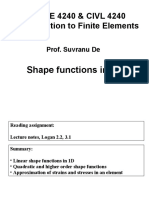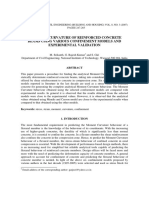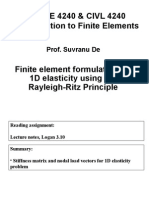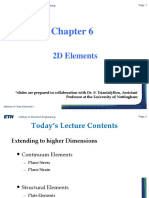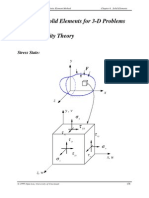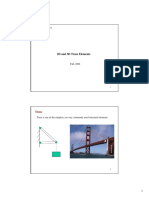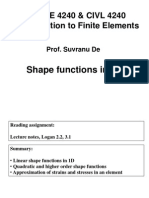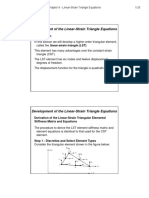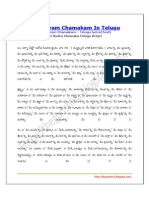Lecture 8
Uploaded by
Prakash KancharlaLecture 8
Uploaded by
Prakash KancharlaLecture 8: Assembly of beam elements.
4.2 Example of Assemblage of Beam Stiffness Matrices. Place nodes at the load application points.
Assembling the two sets of element equations (note the common elemental coordinate system)
MECH 420: Finite Element Applications
Lecture 8: Assembly of beam elements.
Step 5: Assembly.
f1(1) 12 y (1) m1z EI (1) = 3 f2 y L SYM (1) m2 z 6 L -12 6 L d1 y 4 L2 6 L 2 L2 1z 12 6 L d 2 y 4 L2 2 z f 2(2) 12 y (2) m2 z EI (2) = 3 f3 y L SYM (2) m3 z 6 L -12 6 L d 2 y 4 L2 6 L 2 L2 2 z 12 6 L d3 y 4 L2 3 z
Element #1
Element #2
f1(1) F1 y -12 6L 0 0 d1 y y 12 6 L (1) 6 L 4 L2 2 L2 0 0 1 6 L m1z m1z (1) (2) f2 y + f2 y F2 y EI 12 6 L 12 + 12 6 L + 6 L 12 6 L d 2 y = (1) = 3 2 2 2 2 (2) 6 2 6 6 4 4 6 2 L L L + L L + L L L m L m + m z 2 2 2z 2z f 3(2) 0 0 12 6 12 6 L L F3 y d3 y y (2) 0 6L 2 L2 6 L 4 L2 0 3 m3 z m3 z
MECH 420: Finite Element Applications
Lecture 8: Assembly of beam elements.
Step 6: Apply boundary conditions & solve.
1 = d1 y = d3 y = 0
F1 y -12 6L 0 0 d1 y 12 6 L 6 L 4 L2 2 L2 0 0 1 6 L m1z F2 y EI 12 6 L 12 + 12 6 L + 6 L 12 6 L d 2 y = 3 2 2 2 2 6 2 6 6 4 4 6 2 L L L L L L L L + + m L 2z 2 F3 y 0 0 12 6 12 6 L L d3 y 0 6L 2 L2 6 L 4 L2 0 3 m3 z
1000 lbf 24 0 6 L d 2 y +12000 in lbf F2 y EI 2 2 = 0 8 2 m L L 2 2 z 0.0 ft lbf 3 L 2 2 m 6 L 2 L 4 L 3 3z
MECH 420: Finite Element Applications
Lecture 8: Assembly of beam elements.
4.3 Examples of Beam Analysis Using the Direct Stiffness Method. For each element, the state variables have been calculated in the solution step. We can deduce anything to deal with the loading, stress, and strain on the two beam elements. Global nodal forces (the net external forces). Shear and bending moment diagrams Recall from earlier classes (MECH 141 and MECH 220) that a shear and bending moment diagram is a convenient way to locate a design point in a beam. ( x ) allows us to plot the V and M The displacement function v diagrams for any one element or a chain of elements. Continue using Figure 4-7 pg. #162 here. Examples 4.1 4.5 pg.#163-175 should also be reviewed.
MECH 420: Finite Element Applications
Lecture 8: Assembly of beam elements.
Consider a case of:
E = 29 106 psi I = 833 in 4 L = 50.0 in
Structural steel
1000 24 0 6 L d 2 y EI 2 2 1000 = 3 0 8 L 2 L 2 0 L 6 L 2 L2 4 L2 3
1000 lbf 0.024 0 0.3 d 2 y 10 2.42 10 103 0 20 5.0 2 12000 in lbf = 4 0.0 in lbf 12.5 10 0.3 5.0 10.0 3
d 2 y 3.38 104 in 7 2 = 6 10 rad 9.8 106 rad 3
MECH 420: Finite Element Applications
Lecture 8: Assembly of beam elements.
We can now recover the global nodal forces from the original system of equations.
F1 y 0 0 0.0 .012 0.3 .012 0.3 0.3 10.0 0.3 5.0 0 0 0.0 m1z F2 y 2.42 1010 3 .012 0.3 .024 0.0 .012 0.3 3.38 104 in 10 = 4 6 107 rad 0.3 5.0 0.0 20.0 0.3 5.0 m 12.5 10 2 z F3 y 0 0 .012 0.3 .012 0.3 0.0 6 0 0.3 5.0 0.3 10.0 0 9.8 10 rad m3 z 820 lbf 20212 in lbf -1001 lbf = 11810 in lbf A quick check to validate the solution process. 181 lbf -77 in lbf
MECH 420: Finite Element Applications
Lecture 8: Assembly of beam elements.
We can also recapture the nodal forces acting on each element.
f1(1) 0.0 .012 0.3 .012 0.3 818 lbf y 0.3 10.0 0.3 5.0 0.0 20149 in lbf m1(1) z 8 (1) = 1.93 10 = 4 .012 0.3 .012 0.3 3.38 10 in 818 lbf f2 y 0.3 (1) 6 107 rad 5.0 0.3 10.0 20728 in lbf m2 z
Element #1
Element #2
f 2(2) .012 0.3 .012 0.3 3.38 104 in -181 lbf y (2) 6 107 rad -8955 in lbf 0.3 10.0 0.3 5.0 m2 z 8 (2) = 1.93 10 = 0.0 in .012 0.3 .012 0.3 f3 y 181 lbf 6 0.3 (2) -77 in lbf 5.0 0.3 10.0 9.8 10 rad m3 z
MECH 420: Finite Element Applications
Lecture 8: Assembly of beam elements.
From the free body diagrams of the two elements we can construct the shear and bending moment diagrams.
818 lbf
1
818 lbf
181 lbf
2
181 lbf
1
20149 in lbf
2
20728 in lbf
2
8955 in lbf
3
77 in lbf
MECH 420: Finite Element Applications
Lecture 8: Assembly of beam elements.
V and M diagrams are useful when we deal with rather simple beam assemblies. The calculation of maximum axial stresses (for beams these maximum stresses occur at the top and bottom beam surfaces) can be easily coded in advance.
x MAX
d 2v = Ec 2 dx 1 1 2 + 1 ( 6 xL + 1 ( 6 xL 6L ) d 2 L2 ) 4 12 6 L x L d = Ec 3 (12 x + + ( ) ) 1y 1 2y 2 3 3 3 L L L L
x MAX
6 6 ) 4 2 )+ 2 + 4 = Ec d d ( = x MAX x Ec d d ( 1y 1 2 2 2y 1 y 2 y 1 2 =0 x 2 =L L L variation over the L L L L
Node 1 value
element is given by a linear interpolation of the two node values.
Node 2 value
MECH 420: Finite Element Applications
Lecture 8: Work Equivalence for Beams.
4.4 Distributed Loading. Concept of work equivalence is the same as covered for bar elements.
We are looking for four generalized nodal forces that are equivalent to the actual distributed load.
This equivalence must hold for any set of generalized nodal displacements.
MECH 420: Finite Element Applications
Lecture 8: Work Equivalence for Beams.
Case study: a rectangular (constant magnitude) distributed transverse load.
w0 L w = N w dx f = 1y 1 0 2 0 w0 L2 = N 2 w0 dx = m 12 0
w 1z L
w0 L w = N w dx f = 2y 3 0 2 0 w0 L2 = N 4 w0 dx = m 12 0
w 2z L
MECH 420: Finite Element Applications
Lecture 8: Work Equivalence for Beams.
Pg.# 178-179 emphasizes how these equivalent nodal loads must be superposed over other external loads. Example 4.6 looks specifically at how the equivalent point loads superpose over other external loads such as those created by beam supports. The revised form of the element equation becomes
+ f w = k d f = f f 1y 1 w f
w 1y
{ ={f
f 2y 2
w
1
w w f 2y 2
MECH 420: Finite Element Applications
Lecture 8: Work Equivalence for Beams.
Appendix D of Logan (pg.# 752) gives the equivalent nodal loads for a variety of distributed load forms. These results can be applied in the first stages of any analysis. Once you have replaced a distributed load, it is removed from the FDB of the element/system.
Note: these Appendix D results are specific to the beam element we have derived. If we were to change the element type it would affect the shape functions that are associated with each nodal load. If the shape functions change then the integration process tabulated in Appendix D is no longer valid.
MECH 420: Finite Element Applications
You might also like
- Development of An In-House MATLAB Code For Finite Element Analysis of Composite Beam Under Static LoadNo ratings yetDevelopment of An In-House MATLAB Code For Finite Element Analysis of Composite Beam Under Static Load8 pages
- m4l28 Lesson 28 The Direct Stiffness Method: Beams (Continued)No ratings yetm4l28 Lesson 28 The Direct Stiffness Method: Beams (Continued)15 pages
- Science 7 Lesson Plan Anatomy of A Wave (Unit 3, Module 2)50% (2)Science 7 Lesson Plan Anatomy of A Wave (Unit 3, Module 2)5 pages
- CE 6705 Analysis & Design of Buildings Against Hazards: Professor T. BalendraNo ratings yetCE 6705 Analysis & Design of Buildings Against Hazards: Professor T. Balendra29 pages
- University of Engineering & Technology, Peshawar, PakistanNo ratings yetUniversity of Engineering & Technology, Peshawar, Pakistan71 pages
- MANE 4240 & CIVL 4240 Introduction To Finite Elements: Constant Strain Triangle (CST)No ratings yetMANE 4240 & CIVL 4240 Introduction To Finite Elements: Constant Strain Triangle (CST)33 pages
- Girkmann Problem Using Axisymmetric Shell ElementsNo ratings yetGirkmann Problem Using Axisymmetric Shell Elements9 pages
- Other Through Special Points ("Nodes") P P 3 2 1 4 3No ratings yetOther Through Special Points ("Nodes") P P 3 2 1 4 331 pages
- University of Engineering & Technology, Peshawar, PakistanNo ratings yetUniversity of Engineering & Technology, Peshawar, Pakistan64 pages
- GUI Program For 2D-Truss Analysis: Developed in MATLAB 7.0No ratings yetGUI Program For 2D-Truss Analysis: Developed in MATLAB 7.013 pages
- Higher Order Elements: Steps in The Formulation of LST Element Stiffness Equations100% (1)Higher Order Elements: Steps in The Formulation of LST Element Stiffness Equations7 pages
- MANE 4240 & CIVL 4240 Introduction To Finite Elements: Shape Functions in 1DNo ratings yetMANE 4240 & CIVL 4240 Introduction To Finite Elements: Shape Functions in 1D29 pages
- Reading Assignment: Logan 6.2-6.5 + Lecture Notes SummaryNo ratings yetReading Assignment: Logan 6.2-6.5 + Lecture Notes Summary32 pages
- 10-Linear Strain Triangle and Other Types of 2d Elements100% (1)10-Linear Strain Triangle and Other Types of 2d Elements31 pages
- Chapter 8 - Linear-Strain Triangle Equations: Learning ObjectivesNo ratings yetChapter 8 - Linear-Strain Triangle Equations: Learning Objectives31 pages
- MANE 4240 & CIVL 4240 Introduction To Finite Elements: Prof. Suvranu deNo ratings yetMANE 4240 & CIVL 4240 Introduction To Finite Elements: Prof. Suvranu de40 pages
- Lecture - 6 - CH Quad4 Kirchoff Love PlateNo ratings yetLecture - 6 - CH Quad4 Kirchoff Love Plate53 pages
- Chapter 6. Solid Elements For 3-D Problems I. 3-D Elasticity TheoryNo ratings yetChapter 6. Solid Elements For 3-D Problems I. 3-D Elasticity Theory6 pages
- Ce1403 - Basics of Dynamics and Aseismic Design (For Vii - Semester)No ratings yetCe1403 - Basics of Dynamics and Aseismic Design (For Vii - Semester)6 pages
- Institute of Technology School of Post Graduate Studies: Department of Civil EngineeringNo ratings yetInstitute of Technology School of Post Graduate Studies: Department of Civil Engineering34 pages
- Seminariofirenze Ottimizzazione 5 Nov 2012No ratings yetSeminariofirenze Ottimizzazione 5 Nov 2012103 pages
- C 5 O - F E S F: Hapter NE Dimensional Inite Lement Hape UnctionsNo ratings yetC 5 O - F E S F: Hapter NE Dimensional Inite Lement Hape Unctions48 pages
- MANE 4240 & CIVL 4240 Introduction To Finite Elements: Shape Functions in 1DNo ratings yetMANE 4240 & CIVL 4240 Introduction To Finite Elements: Shape Functions in 1D29 pages
- MATLAB Code For Structural Analysis of 2-D Structures Subjected To Static and Self-Weight Loading ConditionsNo ratings yetMATLAB Code For Structural Analysis of 2-D Structures Subjected To Static and Self-Weight Loading Conditions9 pages
- Development of The Linear-Strain Triangle EquationsNo ratings yetDevelopment of The Linear-Strain Triangle Equations26 pages
- On Minimum Weight Design of Statically Loaded Continuous Beams With Deflection ConstraintsNo ratings yetOn Minimum Weight Design of Statically Loaded Continuous Beams With Deflection Constraints6 pages
- Damage Mechanics in Metal Forming: Advanced Modeling and Numerical SimulationFrom EverandDamage Mechanics in Metal Forming: Advanced Modeling and Numerical Simulation4/5 (1)
- Lecture 2: The Direct Stiffness Method: 2.1 Definition of The Stiffness Matrix. First Look at Structural ProblemsNo ratings yetLecture 2: The Direct Stiffness Method: 2.1 Definition of The Stiffness Matrix. First Look at Structural Problems19 pages
- Gbs UIAutomationTestToolComparison 070816 2354 394No ratings yetGbs UIAutomationTestToolComparison 070816 2354 3941 page
- Chapter 3: Basic Elements Section 3 1: Preliminaries (Review of Section 3.1: Preliminaries (Review of Solid Mechanics)No ratings yetChapter 3: Basic Elements Section 3 1: Preliminaries (Review of Section 3.1: Preliminaries (Review of Solid Mechanics)52 pages
- Non-Linear Finite Element Method Simulation and Modeling of The Cold and Hot Rolling ProcessesNo ratings yetNon-Linear Finite Element Method Simulation and Modeling of The Cold and Hot Rolling Processes170 pages
- ECEN 460 Power System Operation and Control: Lecture 20: Transient StabilityNo ratings yetECEN 460 Power System Operation and Control: Lecture 20: Transient Stability25 pages
- 02 Chem X Icse Summary Chemical BondingNo ratings yet02 Chem X Icse Summary Chemical Bonding10 pages
- Esa Eso Hubble Space Telescope Educational Material - Hubble 15 Year of Discovery (English) Series 0.1 - BookNo ratings yetEsa Eso Hubble Space Telescope Educational Material - Hubble 15 Year of Discovery (English) Series 0.1 - Book22 pages
- Nuclei _ Recommended MCQs - (NEW NCERT PATTERN)No ratings yetNuclei _ Recommended MCQs - (NEW NCERT PATTERN)7 pages
- 1614326791758-Objective Questions On Heat Engine & Thermodynamics MET-07No ratings yet1614326791758-Objective Questions On Heat Engine & Thermodynamics MET-0723 pages
- Central Mindanao University Obe-Fl Course Syllabus in Chy 59No ratings yetCentral Mindanao University Obe-Fl Course Syllabus in Chy 5910 pages
- EBCS en 1991 1.5 2014 - Version Final - ThermalActions - SECUREDNo ratings yetEBCS en 1991 1.5 2014 - Version Final - ThermalActions - SECURED27 pages
- A Simple Simulation Technique For Energy Balance of Internal Combustion Engines Under Varaible LoadNo ratings yetA Simple Simulation Technique For Energy Balance of Internal Combustion Engines Under Varaible Load6 pages
- H. R. Vallentine (Auth.) - Applied Hydrodynamics-Springer US (1967) PDFNo ratings yetH. R. Vallentine (Auth.) - Applied Hydrodynamics-Springer US (1967) PDF305 pages
- Development of An In-House MATLAB Code For Finite Element Analysis of Composite Beam Under Static LoadDevelopment of An In-House MATLAB Code For Finite Element Analysis of Composite Beam Under Static Load
- m4l28 Lesson 28 The Direct Stiffness Method: Beams (Continued)m4l28 Lesson 28 The Direct Stiffness Method: Beams (Continued)
- Science 7 Lesson Plan Anatomy of A Wave (Unit 3, Module 2)Science 7 Lesson Plan Anatomy of A Wave (Unit 3, Module 2)
- CE 6705 Analysis & Design of Buildings Against Hazards: Professor T. BalendraCE 6705 Analysis & Design of Buildings Against Hazards: Professor T. Balendra
- University of Engineering & Technology, Peshawar, PakistanUniversity of Engineering & Technology, Peshawar, Pakistan
- MANE 4240 & CIVL 4240 Introduction To Finite Elements: Constant Strain Triangle (CST)MANE 4240 & CIVL 4240 Introduction To Finite Elements: Constant Strain Triangle (CST)
- Girkmann Problem Using Axisymmetric Shell ElementsGirkmann Problem Using Axisymmetric Shell Elements
- Other Through Special Points ("Nodes") P P 3 2 1 4 3Other Through Special Points ("Nodes") P P 3 2 1 4 3
- University of Engineering & Technology, Peshawar, PakistanUniversity of Engineering & Technology, Peshawar, Pakistan
- GUI Program For 2D-Truss Analysis: Developed in MATLAB 7.0GUI Program For 2D-Truss Analysis: Developed in MATLAB 7.0
- Higher Order Elements: Steps in The Formulation of LST Element Stiffness EquationsHigher Order Elements: Steps in The Formulation of LST Element Stiffness Equations
- MANE 4240 & CIVL 4240 Introduction To Finite Elements: Shape Functions in 1DMANE 4240 & CIVL 4240 Introduction To Finite Elements: Shape Functions in 1D
- Reading Assignment: Logan 6.2-6.5 + Lecture Notes SummaryReading Assignment: Logan 6.2-6.5 + Lecture Notes Summary
- 10-Linear Strain Triangle and Other Types of 2d Elements10-Linear Strain Triangle and Other Types of 2d Elements
- Chapter 8 - Linear-Strain Triangle Equations: Learning ObjectivesChapter 8 - Linear-Strain Triangle Equations: Learning Objectives
- MANE 4240 & CIVL 4240 Introduction To Finite Elements: Prof. Suvranu deMANE 4240 & CIVL 4240 Introduction To Finite Elements: Prof. Suvranu de
- Chapter 6. Solid Elements For 3-D Problems I. 3-D Elasticity TheoryChapter 6. Solid Elements For 3-D Problems I. 3-D Elasticity Theory
- Ce1403 - Basics of Dynamics and Aseismic Design (For Vii - Semester)Ce1403 - Basics of Dynamics and Aseismic Design (For Vii - Semester)
- Institute of Technology School of Post Graduate Studies: Department of Civil EngineeringInstitute of Technology School of Post Graduate Studies: Department of Civil Engineering
- C 5 O - F E S F: Hapter NE Dimensional Inite Lement Hape UnctionsC 5 O - F E S F: Hapter NE Dimensional Inite Lement Hape Unctions
- MANE 4240 & CIVL 4240 Introduction To Finite Elements: Shape Functions in 1DMANE 4240 & CIVL 4240 Introduction To Finite Elements: Shape Functions in 1D
- MATLAB Code For Structural Analysis of 2-D Structures Subjected To Static and Self-Weight Loading ConditionsMATLAB Code For Structural Analysis of 2-D Structures Subjected To Static and Self-Weight Loading Conditions
- Development of The Linear-Strain Triangle EquationsDevelopment of The Linear-Strain Triangle Equations
- On Minimum Weight Design of Statically Loaded Continuous Beams With Deflection ConstraintsOn Minimum Weight Design of Statically Loaded Continuous Beams With Deflection Constraints
- Damage Mechanics in Metal Forming: Advanced Modeling and Numerical SimulationFrom EverandDamage Mechanics in Metal Forming: Advanced Modeling and Numerical Simulation
- Lecture 2: The Direct Stiffness Method: 2.1 Definition of The Stiffness Matrix. First Look at Structural ProblemsLecture 2: The Direct Stiffness Method: 2.1 Definition of The Stiffness Matrix. First Look at Structural Problems
- Gbs UIAutomationTestToolComparison 070816 2354 394Gbs UIAutomationTestToolComparison 070816 2354 394
- Chapter 3: Basic Elements Section 3 1: Preliminaries (Review of Section 3.1: Preliminaries (Review of Solid Mechanics)Chapter 3: Basic Elements Section 3 1: Preliminaries (Review of Section 3.1: Preliminaries (Review of Solid Mechanics)
- Non-Linear Finite Element Method Simulation and Modeling of The Cold and Hot Rolling ProcessesNon-Linear Finite Element Method Simulation and Modeling of The Cold and Hot Rolling Processes
- ECEN 460 Power System Operation and Control: Lecture 20: Transient StabilityECEN 460 Power System Operation and Control: Lecture 20: Transient Stability
- Esa Eso Hubble Space Telescope Educational Material - Hubble 15 Year of Discovery (English) Series 0.1 - BookEsa Eso Hubble Space Telescope Educational Material - Hubble 15 Year of Discovery (English) Series 0.1 - Book
- 1614326791758-Objective Questions On Heat Engine & Thermodynamics MET-071614326791758-Objective Questions On Heat Engine & Thermodynamics MET-07
- Central Mindanao University Obe-Fl Course Syllabus in Chy 59Central Mindanao University Obe-Fl Course Syllabus in Chy 59
- EBCS en 1991 1.5 2014 - Version Final - ThermalActions - SECUREDEBCS en 1991 1.5 2014 - Version Final - ThermalActions - SECURED
- A Simple Simulation Technique For Energy Balance of Internal Combustion Engines Under Varaible LoadA Simple Simulation Technique For Energy Balance of Internal Combustion Engines Under Varaible Load
- H. R. Vallentine (Auth.) - Applied Hydrodynamics-Springer US (1967) PDFH. R. Vallentine (Auth.) - Applied Hydrodynamics-Springer US (1967) PDF

















